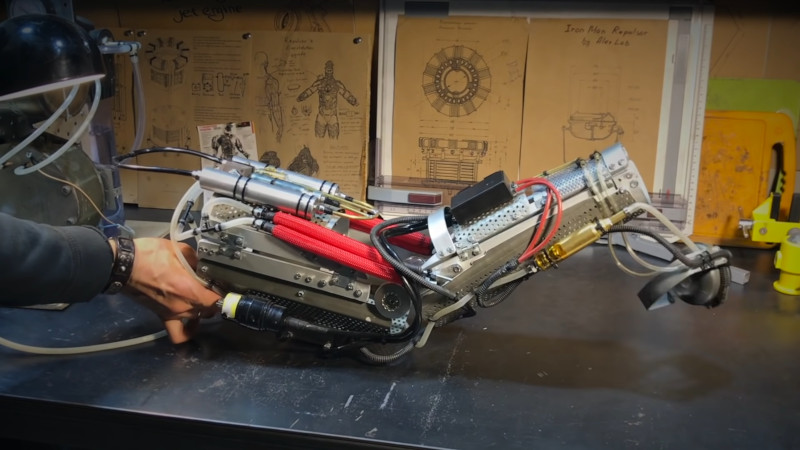The idea of building a suit that increases the wearer’s strength is a compelling one, often featured in science fiction. There are a handful of real world examples, and [Alex] can now add his to the list. The build comes with a twist however, relying on hydrogen to do the work.
At its heart, the build is not dissimilar to other artificial muscle projects. The muscles in [Alex’s] build consist of a rubber tube inside a nylon braid. When the rubber tube is inflated, it expands, causing the nylon braid to shorten as it grows wider. Commonly, such builds rely on compressed air to power the muscles, however [Alex] took a different path. Instead, water is electrolysed in a chamber designed to look like Iron Man’s arc reactor, with the resulting gases produced being used to drive the muscles. With five muscles ganged up to pull together, the wearable arm support is capable of generating up to 15 kg of pull force.
It’s a design that has a few benefits; the electrolyser has no moving parts, and is much simpler and quieter than a typical air compressor. Obviously, there is a risk of fire thanks to the flammable gases used, but [Alex] explains the precautions taken to minimise this risk in the video.
Exosuits may not be mainstream just yet, but that doesn’t mean people aren’t working to make them a reality. We’ve featured a few before, like this open-source design. Video after the break.
[Thanks to Keith Olson for the tip!]
















Interesting notion. How efficient is it? E.g. how much power must my battery deliver to yield (say) 100W of motive power (about what one bicep does during a curl)?
A SWAG, using an Elon Musk style first-principles analysis: A bicep curl needs about 20 kg x 0.5m = 100J of energy. To provide that pressure * volume in an ideal gas (PV=nRT) will need 0.040 mol of gas, requiring 0.027 mol of water (or 0.5 g). Water needs 286 kJ/mol = 16 kJ/g to split into gas. A good electrolyzer might then need around 10 kJ of electrical input to make that 0.5g of gas.
10 kJ of battery energy for one bicep curl. About the entire energy of one 18650 Li-ion cell.
Wheaties might be a better bet. And, unless you have a severe gluten intolerance, probably less explosion hazard.
Wheaties won’t get you a hand burner, that can melt a tincan down, though.
So, the energy is not all wasted, you have the energy rich gases as a result, too.
(if I did not miss something, only skimmed through the video).
Anyway, it is probably not the best approach, though, if you want a mobile exoscelet to be in service for some time. But still pretty awesome
if you could make it nuclear powered, you could ditch all the 18650s. =) Then again, you could ditch all the hydrogen too.
Nuclear reactors of useful power output are generally based on steam engines which take up quite a lot of space and weight.
One way to get some of the remaining energy might be to have a “killer punch” feature, where the flammable gasses are detonated on the tricep side.
Needs to make that, Six-Million Dollar Man bionic noises when activated.
LOL “flammable gases”
the mother of all understatements
As long as the hydrogen–oxygen reaction isn’t well oxygenated it burns rather slowly. Hence Hindenburg burned and didn’t pop.
If a fuel is safe enough for a civilian rocket, it won’t kill you for looking at it.
If a fuel is too unsafe for a military rocket, you probably don’t want to be anywhere near it, even if it’s cooled solid and in a bunker.
That’s right. Boiling the water would give us a better efficiency figure.
OTOH, if we don’t go to the trouble to separate the electrolysis gasses and put a spark plug somewhere in there… that would be a damn fast muscle contraction!
Powered exoskeletons always sound like an awesome project. And then I consider a small programming error or a reversed pair of wires hyper extending one of my limbs with superhuman strength.
The scene in the first iron man when you see the video of the hammer industries suit spinning the torso completely around multiple times. Justin Hammer shouts “I’d like to point out that pilot survived!”. That’s what I think of too.
Hydrogen has such a low ignition energy that it will spontaneously ignite when pressurized with oxygen. The guy is playing russian roulette with this setup.
If you watch the video you’ll note he does acknowledge that. He might be crazy, but he’s not stupid.
Yet he did nothing to solve the problem.
It takes about 20 micro-Joules to ignite the mixture, so a tiny static spark, sudden compression, or friction in the valves is enough to set it off. It simply cannot be stored safely under pressure. Pressurized oxyhydrogen is an accident waiting to happen.
To add injury to injury, oxyhydrogen mixtures detonate above 30 – 50 psi. This means his gas generator will not only blow out, it becomes a grenade.
Damn! just spent better part of the morning going down the rabbit hole on his channel and other electrolysis methods. Now, cutting torch? Where did I put that lawn mower engine that needs a conversion, maybe hybrid engine that charges batteries that runs off of this… I dunno, have to try it out.
You got only one example about how dangerous Hydrogen is?
Come on.
can anyone leave a free download link of the Repulsor & Exoskeleton pdf manufacturing guide
The increase in the number of orthopedic surgeries is expected to drive the healthcare exoskeleton market.